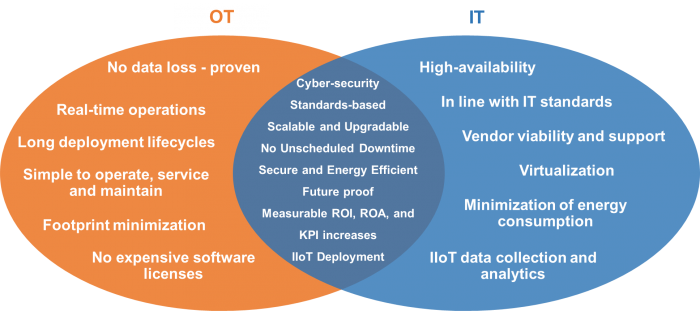

The increasing convergence of operational technology (OT) and information technology (IT), otherwise known as OT-IT Convergence, across industry and infrastructure was a recurring theme at the recent ARC Industry Forum in Orlando, Florida. The increasing convergence between OT and IT in today’s industrial plants has led to a rapid learning curve for both groups. In general, IT groups are just starting to learn what “real time” means, and OT groups are starting to learn how they can best leverage IT-enabled technologies in operations. Also, while IT groups have traditionally focused on preserving data integrity and data flows, OT groups are typically more concerned about non-stop system availability to help ensure 24/7 plant operations and plant and employee safety.
OT-IT convergence requires both groups to work together to figure out how to connect the large installed base of legacy OT assets (control systems, instrumentation, etc.) with today’s powerful IT-enabled solutions to improve business performance without compromising system availability. The reality is that we still have 30-year-old legacy assets in our plants and we simply can’t afford to do a wholesale ‘rip and replace’. This makes it necessary to figure out how to connect our legacy control systems to an IIoT world.
As automation systems become more complex, the probability of human-influenced errors increases. Anything that can be done to reduce complexity should be considered and implemented, as this will help minimize the probability of human error. One of the major challenges involves the dramatically different lifecycles be-tween OT and IT. While process control systems and field networks typically remain in service for 20 to 30 years or more, most IT is updated or replaced every several years to avoid technological obsolescence in this rapidly evolving space.
Another significant challenge that has emerged in recent years involves ownership and responsibility. In this case, the convergence of real-time operations technology with transactional information technology, is just one element of technology change to which organizations must adapt. To prevent declining performance, it’s critical for an organization to assess both its maturity and its ability to evolve and change. Whatever the cause (technology, economics, geopolitical, etc.), organizations need to re-fresh their thinking periodically and modify their organizational design to adapt and survive.
As the needs of OT and IT are beginning to converge, so does the obvious focus on cybersecurity. OT’s focus on non-stop operations and eliminating unscheduled downtime is raising the cybersecurity issue on the IT side, and increased data from IT is raising the same issue on the OT side. Each organization’s behavior is driven by what they value, how they think, and how they are rewarded. OT professionals prioritize availability over everything else. This includes systemwide integrity and security. Unless the few-and-far-between upgrades are going on, system access is generally limited and the environment is stable. IT thinks differently. Their priorities are characterized by access security – ensuring that only the right people have access to the right systems and that malicious actors cannot gain access. IT systems typically require frequent – often daily - software patches and updates, which can be more difficult to accommodate in a non-stop, 24/7 production environment, especially if OT system downtime is required to perform the patch or update.
Despite these and other challenges, OT-IT convergence offers significant potential benefits; many that are already well-proven in industrial plants and factories around the world. These include reduced process variability and energy consumption, along with improved product quality, asset health and reliability, incident prediction to avoid upsets, responsiveness to customers, and the ability to attract a modern workforce. Other benefits include more streamlined work processes, and a better ability to take advantage of emerging technologies.


